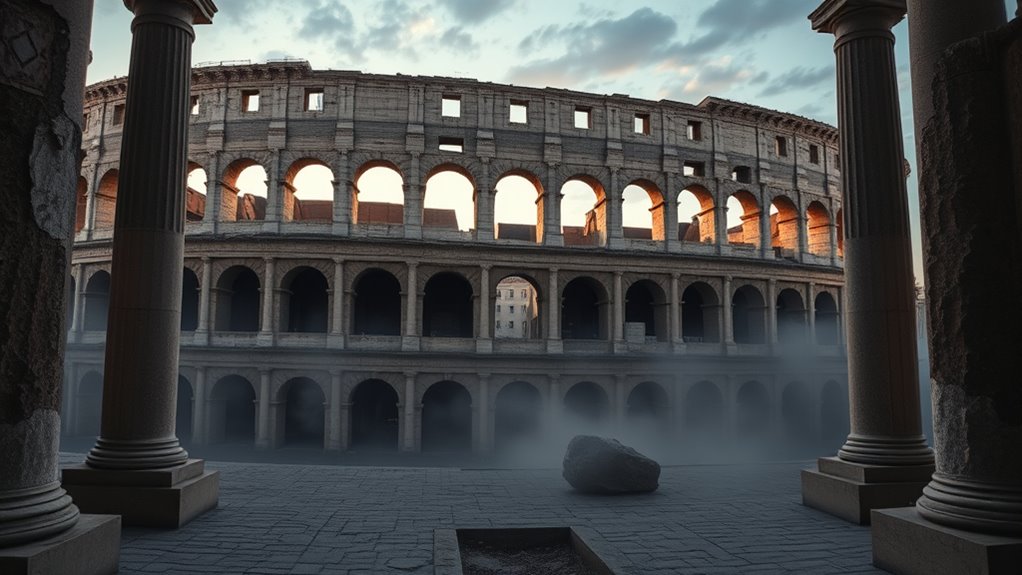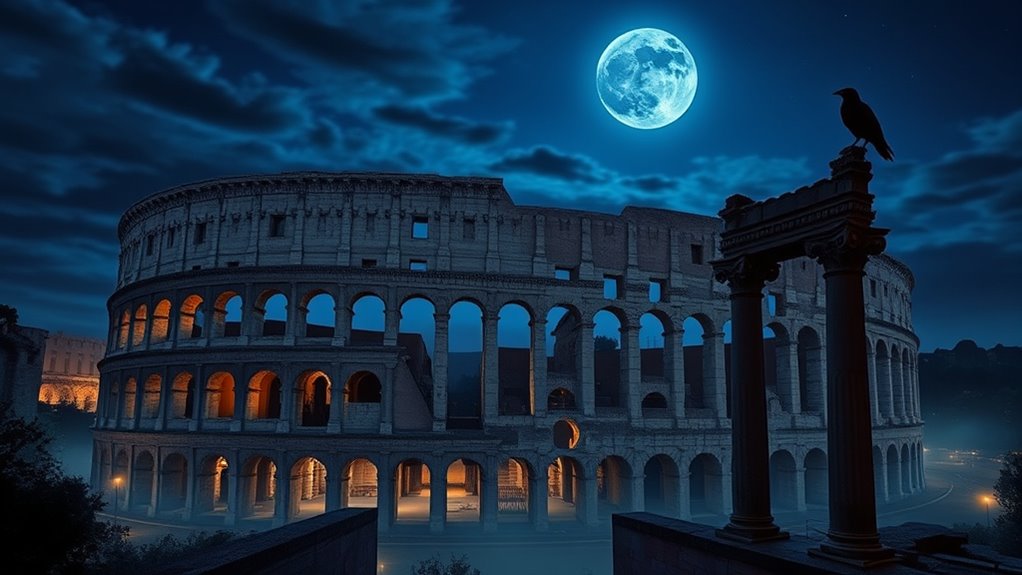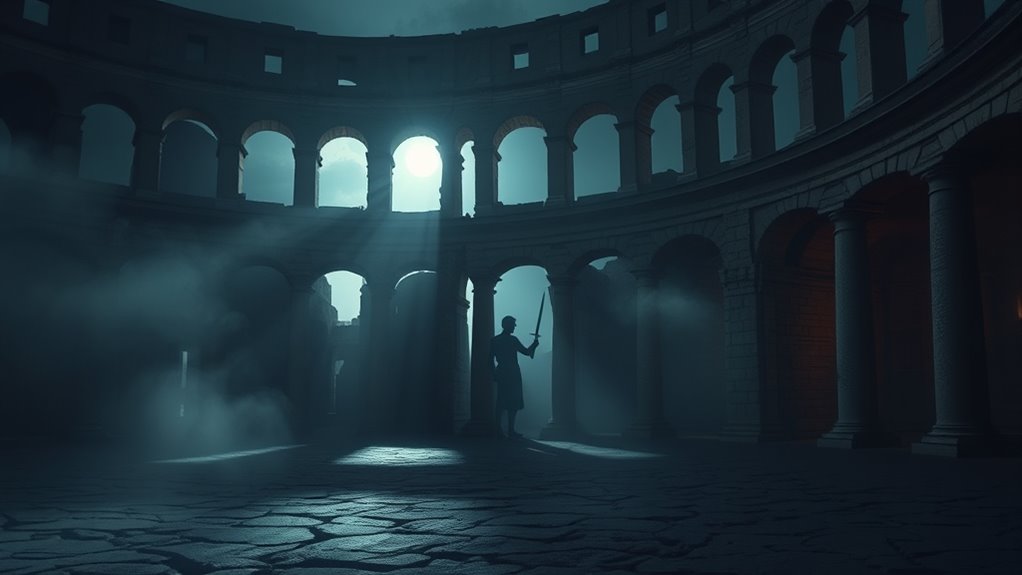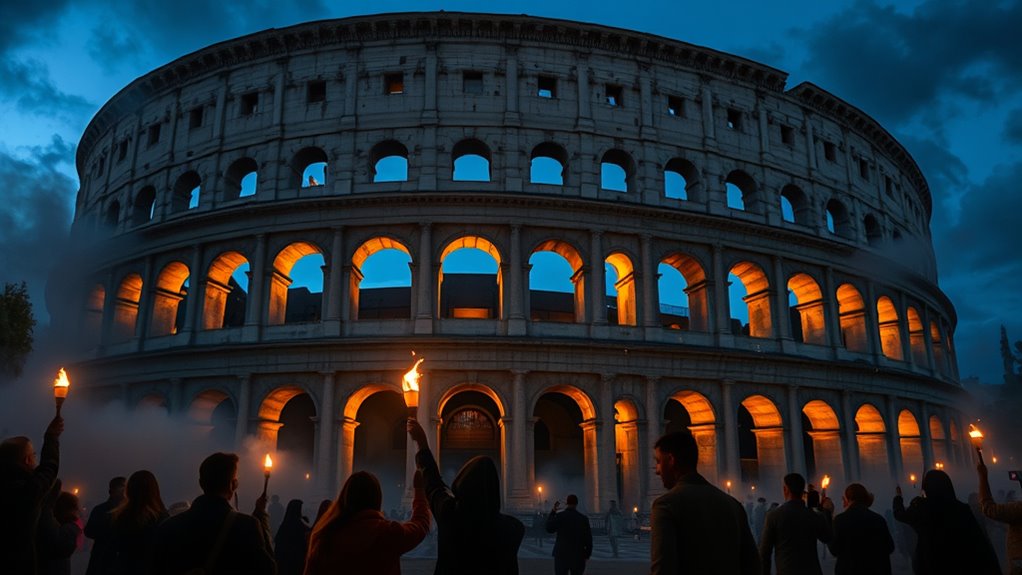The Colosseum isn’t just an iconic landmark; it’s a haunting reminder of ancient Rome’s dark past. You’ll hear whispers of gladiators and see eerie spectral figures as they reenact battles. Visitors often report cold drafts and disembodied sounds echoing through the arena. The ghost of Messalina, with her intriguing backstory, adds another layer of mystery. The legends and ghostly encounters weave a enthralling tapestry of history, which only gets deeper as you explore further.
Key Takeaways
- The Colosseum, built in AD 72-80, hosted brutal spectacles like gladiatorial contests and executions, contributing to its haunting legacy.
- Visitors report ghostly sightings of gladiators and disembodied sounds, enhancing the eerie atmosphere surrounding this historic site.
- The ghost of Messalina, known for her scandalous past, is frequently spotted near the Colosseum, adding to its mystical allure.
- Cultural ghost stories, including legends of gladiators, attract both tourists and locals, enriching Rome’s historical narrative and heritage.
- Ongoing restoration efforts aim to preserve the Colosseum while enhancing its ghostly charm and visitor experience through ghost tours.
A Glimpse Into the Colosseum’s Historical Significance

As you step into the Colosseum, you can’t help but feel the weight of its historical significance. Built between AD 72 and AD 80 under emperors Vespasian and Titus, the Colosseum symbolizes Roman power and architectural brilliance.
With a staggering capacity of 50,000 to 80,000 spectators, it became a hub for public spectacles, from gladiatorial contests to animal hunts. Imagine the roar of the crowd echoing through its arches, a stark contrast to the grim reality of an estimated 500,000 to 1 million human deaths that occurred within its walls.
Today, as the most popular tourist attraction in Italy, the Colosseum continues to draw millions, ensuring its legacy endures through ongoing renovations that preserve its rich history.
The Colosseum: Arena of Bloodshed and Glory

The Colosseum wasn’t just a marvel of architecture; it was a stage for some of the most brutal and exhilarating spectacles in ancient Rome.
With a capacity for 50,000 to 80,000 spectators, the amphitheater hosted gladiatorial contests, public executions, and animal hunts. Can you imagine the roar of the crowd as they witnessed the clash of swords and the final moments of condemned souls?
An estimated 500,000 to 1 million human deaths occurred within these walls, contributing to its dark legacy. Ingenious Roman engineering even allowed the arena to flood for naval battles, adding to the bloodshed and glory.
The intense atmosphere of violence has left behind whispers of ghostly apparitions, making the Colosseum one of the world’s most haunted sites.
The Legend of Gladiators and Their Spirits

As you step into the Colosseum, you can’t help but feel the weight of the gladiators’ stories, their rigorous training and tragic fates echoing through the ages.
Many visitors report spectral sightings of these warriors, their spirits seemingly caught in an eternal battle.
The emotional energy imprints from their struggles linger, adding to the haunting atmosphere that surrounds this iconic arena.
Gladiators’ Training and Background
Gladiators, often hailed as heroes in ancient Rome, faced a harsh reality that few could imagine.
Trained in specialized schools called ludus gladiatorius, these fighters endured grueling physical conditioning and combat drills. Most were slaves, prisoners of war, or condemned criminals, thrust into a brutal existence where survival meant mastering the art of fighting.
The Colosseum became their stage, hosting intense one-on-one duels, chaotic group battles, and even public executions, all watched by enthusiastic crowds.
While society revered gladiators for their bravery, the emotional toll of their experiences left an indelible mark on the Colosseum.
Today, whispers of their spirits wandering the amphitheater serve as a haunting reminder of the valor and tragedy that defined their lives.
Spectral Sightings in Colosseum
Could the echoes of ancient battles still linger within the Colosseum’s walls? Visitors often share chilling ghost stories of fallen gladiators haunting the arena.
Here are some common experiences:
- Spectral Figures: Witnesses describe shadowy forms reenacting gladiators’ final moments.
- Disembodied Sounds: Many report hearing swords clash and anguished screams echoing through the corridors.
- Chilling Atmosphere: Guests frequently feel sudden drops in temperature, heightening their unease.
- Ghostly Crowds: Some claim to see phantom audiences cheering or jeering from the stands, adding to the arena’s haunting ambiance.
These sightings, coupled with the tragic emotions tied to the Colosseum’s history, create a powerful resonance that keeps the legends of its spirits alive.
Emotional Energy Imprints
The Colosseum’s haunting atmosphere isn’t just about the spectral figures and disembodied sounds; it’s deeply tied to the emotional energy imprinted within its ancient walls.
This site of immense bloodshed absorbed the intense feelings of countless gladiators and victims, creating residual hauntings that linger in the air. As you wander through the corridors, you might catch glimpses of ghostly gladiators, their spirits wandering in a state of agony and despair.
You may even hear the echoes of swords clashing or the anguished cries of those who fought and died for entertainment. The pervasive despair from these tragic events has formed a reservoir of emotional energy imprints, enriching the Colosseum’s chilling allure and reinforcing its reputation as a haunted landmark.
Paranormal Encounters: Ghostly Sightings at the Colosseum

Have you ever wondered what lingering spirits might haunt the ancient corridors of the Colosseum? Many visitors report ghostly sightings that send chills down their spines.
Here are some common encounters you might experience:
Common ghostly encounters await you at the Colosseum, where history and the supernatural intertwine in eerie ways.
- Gladiator Apparitions: Ghostly gladiators wander the corridors, embodying the fierce battles once fought.
- Spectral Spectators: Groups of ethereal figures fill the stands, cheering and jeering as if reliving the thrilling contests.
- Disembodied Sounds: You might hear the clashing of swords, screams, and echoes of pain, remnants of the Colosseum’s brutal past.
- Eerie Temperature Drops: Sudden chills and light anomalies can create an unsettling atmosphere during your visit.
These ghostly sightings add an uncanny layer to the Colosseum’s rich history, inviting you into its haunted narrative.
The Haunting of Messalina: A Ghostly Tale

As you wander near the Colosseum at night, you might just encounter the ghost of Messalina, a woman whose life was as dramatic as her tragic end.
Known for her notorious affairs and noble status, her spirit reportedly roams in search of new lovers, enchanting those who witness her ethereal presence.
These sightings not only highlight her fascinating history but also weave her ghostly tale into the rich cultural fabric of Rome.
Messalina’s Historical Background
Though she was thrust into a marriage with the older Emperor Claudius at just fourteen, Messalina quickly carved out a notorious reputation in ancient Rome.
Her life, marked by scandal and intrigue, unfolded years ago but still captivates imaginations today.
Here are some key points about her tumultuous existence:
- Messalina engaged in numerous extramarital affairs, shocking Roman society.
- Her affair with consul Gaius Silio ultimately led to her execution at just 23.
- Chroniclers like Suetonius and Tacitus documented her dramatic life and death.
- Legends claim her ghost haunts the Colosseum, eternally searching for love.
Messalina’s story reflects the complexities of power, desire, and the haunting consequences of her choices.
Ghostly Sightings Reported
While wandering the quiet streets of Rome at night, you might just encounter the ethereal figure of Messalina, her ghostly presence lingering near the Colosseum. Witnesses describe her as a woman in a white peplum, adorned with jewels, embodying her noble status. Homeless individuals and passers-by often report ghostly sightings, especially when the city sleeps. Messalina’s haunting reflects her tragic legacy, forever seeking new lovers under the moonlight.
| Witness Type | Description | Location |
|---|---|---|
| Homeless | Noticed glowing figure | Near the Colosseum |
| Passer-by | Saw her beckoning | Colosseum entrance |
| Tourists | Captured her on camera | Surrounding areas |
| Locals | Heard whispers | Nearby alleyways |
| Historians | Studied her legend | Colosseum vicinity |
Cultural Significance of Legends
The haunting of Messalina isn’t just a ghost story; it embodies the cultural significance of legends that shape Rome’s identity. Her tragic tale reflects the complexities of power and love, making it a cornerstone of Roman folklore.
- Messalina’s ghost, draped in a jeweled white peplum, symbolizes her noble but scandalous past.
- Her life, marked by a forced marriage and infidelity, echoes the darker sides of ambition.
- Sightings near the Colosseum, especially at night, enhance the mystery of her legend.
- Ghost tours often feature her narrative, offering visitors a glimpse into Rome’s vibrant mythos.
Through Messalina’s haunting, you experience the intertwining of history and cultural storytelling in the Eternal City. The importance of celebrating relationships is evident in how her story continues to resonate with audiences, reminding us of the enduring nature of love and ambition.
The Cultural Impact of Ghost Stories in Rome

As you wander through the streets of Rome, it’s hard not to feel the weight of its ghost stories, which blend historical figures with supernatural elements to create a fascinating tapestry of culture.
Tales like that of Messalina enrich the city’s narrative, enchanting both locals and tourists. The Colosseum, steeped in a haunted reputation, draws visitors keen to experience its eerie past firsthand.
Local ghost tours weave these spectral tales into educational journeys, offering immersive encounters with Rome’s rich history.
The prevalence of ghost stories in Rome not only preserves cultural heritage but also prompts deeper reflections on human nature and mortality, especially within the haunting shadows of the Colosseum, a powerful symbol of the city’s violent history.
Visitor Experiences: Capturing the Supernatural

What makes a visit to the Colosseum unforgettable? The thrilling experiences of the supernatural await you. Many visitors report eerie encounters, including:
- Ghostly apparitions: Tourists often spot Roman soldiers or spectral crowds in the stands.
- Paranormal photographs: Night tours frequently capture orbs and other strange phenomena in images.
- Temperature drops: You might feel sudden chills or an overwhelming sense of dread while exploring.
- Disembodied sounds: Guests have heard anguished moans and the clash of swords echoing through the arena.
Engaging with fellow visitors online, you can share your ghostly stories, creating a community fascinated by the Colosseum’s haunted history.
Each visit becomes a chance to connect with the past and perhaps glimpse the extraordinary.
Restoration and Preservation of the Colosseum

While exploring the supernatural experiences at the Colosseum, it’s important to recognize the ongoing efforts to restore and preserve this iconic structure.
The restoration project, which began with a facade cleanup in 2016, now includes the opening of underground passages to the public. Over 80 archaeologists, architects, and engineers are dedicated to restoring the hypogeum and creating a new walkway for better visitor access.
This ambitious restoration is divided into three phases, with the final phase set to renew galleries and enhance the lighting system. Funded by the Italian fashion group Tod’s, which pledged 25 million euros, these preservation efforts guarantee that the Colosseum remains a crucial part of Italy’s rich heritage for generations to come.
Exploring Rome’s Haunted Heritage Through Tours

If you’re keen to uncover the eerie tales that lie beneath Rome’s vibrant surface, exploring the haunted heritage of the Colosseum through guided tours is a must.
These ghost tours offer a unique perspective on the ancient arena’s dark past, connecting you to its history in a spine-tingling way.
Here are four enthralling aspects you’ll experience:
- Discover the chilling tales of gladiatorial battles and public executions.
- Listen for the haunting sounds of anguish and sightings of apparitions.
- Learn about historical figures like Messalina, whose ghost reportedly roams the Colosseum at night.
- Engage with local myths and legends that enrich your understanding of Rome’s cultural tapestry.
Don’t miss the chance to investigate this haunting history!
Frequently Asked Questions
What Are Some Dark Facts About the Colosseum?
The Colosseum’s history is filled with dark facts that might shock you.
It’s estimated that between 500,000 and 1 million people died there, mostly during brutal gladiatorial games and public executions. The arena was a place of immense suffering, where spectators cheered as lives were extinguished.
Additionally, the Colosseum served as a venue for animal hunts and other horrific spectacles, showcasing humanity’s darker side, leaving a haunting legacy that still resonates today.
What Is the Brutal History of the Colosseum?
Have you ever wondered what horrors unfolded within the Colosseum’s massive walls?
Built to host gladiatorial contests, it became a stage for bloodshed, where slaves and prisoners fought for survival.
You’ll find that gruesome spectacles, including public executions and animal hunts, claimed countless lives, with estimates reaching up to a million deaths.
The arena, a symbol of Roman cruelty, showcased a society obsessed with power and violence, leaving a dark legacy that still echoes today.
What Was the Secret Area in the Colosseum?
The secret area in the Colosseum is known as the hypogeum.
It’s an intricate network of underground chambers and passages where gladiators and animals waited before their performances.
You’d find a system of pulleys and trapdoors that created dramatic entrances during events.
Recently restored and opened to the public, the hypogeum reveals a fascinating aspect of the Colosseum’s architecture and its role in the elaborate spectacles of ancient Rome.
How Many Animals Were Believed to Be Killed in the First 100 Days of the Colosseum Being Opened?
In the first 100 days after the Colosseum opened, it’s estimated that around 9,000 animals were killed.
You can imagine the spectacle of these brutal games, where exotic beasts like lions and elephants were showcased for entertainment.
The sheer number of animal deaths highlights the violent nature of these events, setting a grim tone for future spectacles.
This early display of cruelty became a hallmark of the Colosseum’s infamous reputation in ancient Rome.
Conclusion
As you stand in the shadow of the Colosseum, you can almost hear the echoes of its past—the whispers of gladiators and the chilling tales of restless spirits. This ancient arena isn’t just stone and history; it’s a living tapestry woven with stories of glory and tragedy. Whether you’re a skeptic or a believer, the Colosseum invites you to explore its haunted legacy, reminding us that some echoes of history never truly fade away.









